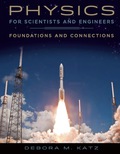
(a)
The position of center of mass at
(a)
Answer to Problem 67PQ
The position of center of mass at
Explanation of Solution
Write the expression for velocity of center of mass.
Here,
Conclusion:
Substitute,
Substitute,
Therefore, the position of center of mass at
(b)
The velocity of the centre of mass.
(b)
Answer to Problem 67PQ
The velocity of the centre of mass is
Explanation of Solution
Velocity is the time derivative of position.
Here,
Substitute equation (II) in equation (III).
Conclusion:
Substitute,
Therefore, velocity of the centre of mass is
(c)
The total linear momentum of the system.
(c)
Answer to Problem 67PQ
The total linear momentum of the system is
Explanation of Solution
Write the expression for momentum.
Conclusion:
Substitute,
Therefore, the total linear momentum of the system is
Want to see more full solutions like this?
Chapter 10 Solutions
Physics for Scientists and Engineers: Foundations and Connections
- A uranium nucleus (mass 238 units) at rest decays into helium nucleus (mass 4.0 units) and thorium nucleus (mass 234 units). If the speed of the helium nucleus is 6.0 x 10^5 m/s, what is the speed of the thorium nucleus?arrow_forwardThe force F has a magnitude of 490 N. Express F as a vector in terms of the unit vectors i and j. Identify the x and y scalar components of F. Assume F = 490 N, 0 = 37% y 1 j) N Answers: F = (i Fx= i Fy || i 0 F -X i+ i N Z Z Narrow_forwardIn the product F = qv(x) B, take q = 5, v= 2.0i + 4.0j + 6.0k and F = −30.0i −60.0j + 50.0k What then is B in unit-vector notation if Bx =B y?arrow_forward
- Position vector= r = (4t^2 +t^2)i + (3t^4 + t^2 + 8)j + (2t^2)k. Find velocity v acceleration a, P=momentum, Force=F?arrow_forwardConsider the following vectors: A = 4.9i + 4.3j + 4.8k B = -7.5i + 6.8j + 10.1k A)What is the x-component of the vector V = 3(A × 2B)? b)What is the y-component of the vector V = 3(A × 2B)? c)What is the z-component of the vector V = 3(A × 2B)? d) What is the magnitude of the vector V?arrow_forwardThe velocity of a particle in reference frame A is (5.0î + 5.0ĵ) m/s. The velocity of reference frame A with respect to reference frame B is 6.0 m/s, and the velocity of reference frame B with respect to C is 4.0ĵ m/s. What is the velocity of the particle (in m/s) in reference frame C? (Express your answer in vector form.)arrow_forward
- E Vectors → and are shown in the figure. Vector is given by →→→→. The magnitude of A B C C B A vectoris 16.0 units, and the magnitude of vectoris 7.00 units. What is the angle of vector, A B measured counterclockwise from the +x-axis? 41.0 F4 S4 31.0 B 73.1° 287° F5 R % 5 V F6 T G Bi F7 B C H F8 & 7 00 D F9 * 00 J N M F10 K F11 FO: L F12 P PrtScr [ Insert ? 81°F Sunny ^ Delete Backspace ] PgUparrow_forwardThe force F has a magnitude of 540 N. Express F as a vector in terms of the unit vectors i and j. Identify the x and y scalar components of F. Assume F = 540 N, 0 = 28% 0 j) N T Answers: F = (i Fx i Fy= i II F i+ i N Narrow_forwardConsider the following vectors: A = 1.2i + 4.9j + 3.7k B = -8.5i + 7.5j + 8.3k Part (a) What is the x-component of the vector V = 3(A × 2B)? Part (b) What is the y-component of the vector V = 3(A × 2B)? Part (c) What is the z-component of the vector V = 3(A × 2B)? Part (d) What is the magnitude of the vector V?arrow_forward
- A big boulder has a mass of 8.20t (metric tons) and rests at a coal mine site. The boulder is blown up with explosives into 3 parts, all the 3 parts move horizontally in the xy plane. The biggest part (mass 3.3 t) travels west at a speed of 3m/s. The second part (mass 2.7t) moves at 2m/s in a direction 25.0 degrees south of east. What is the speed and direction of the third boulder part?arrow_forwardA high-speed aircraft takes-off in the xyz-plane and the coordinates are given by x(t) = αt, y(t) = 3.0 m − βt^2, and z(t) = αt − γt^3, where α = 2.4 m/s, β = 1.2 m/s^2, and γ = 0.6 m/s^3. Calculate:a) The velocity and acceleration vectors of the high-speed aircraft as functions of time.b) The magnitude of the high-speed aircraft’s velocity and acceleration after 2 sec.arrow_forwardWhat is the component of the force vector G = (3.0i + 4.0j + 10.0k )N along the force vector H = (1.0i + 4.0j )N ?arrow_forward
 Principles of Physics: A Calculus-Based TextPhysicsISBN:9781133104261Author:Raymond A. Serway, John W. JewettPublisher:Cengage Learning
Principles of Physics: A Calculus-Based TextPhysicsISBN:9781133104261Author:Raymond A. Serway, John W. JewettPublisher:Cengage Learning
